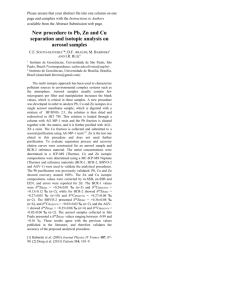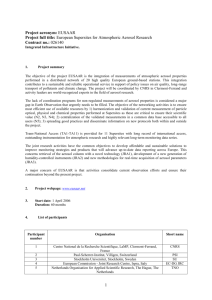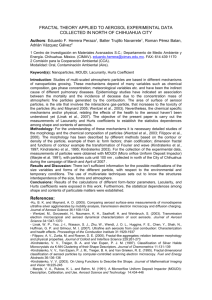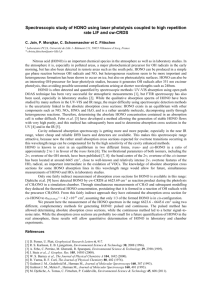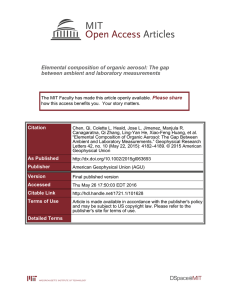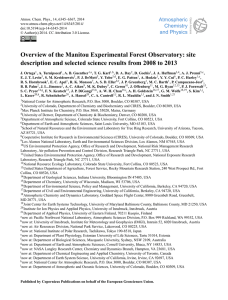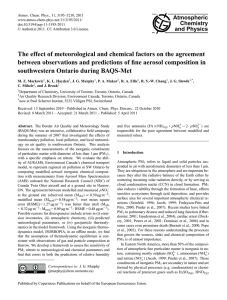jgrd52603-sup-0001-Supplementary
advertisement
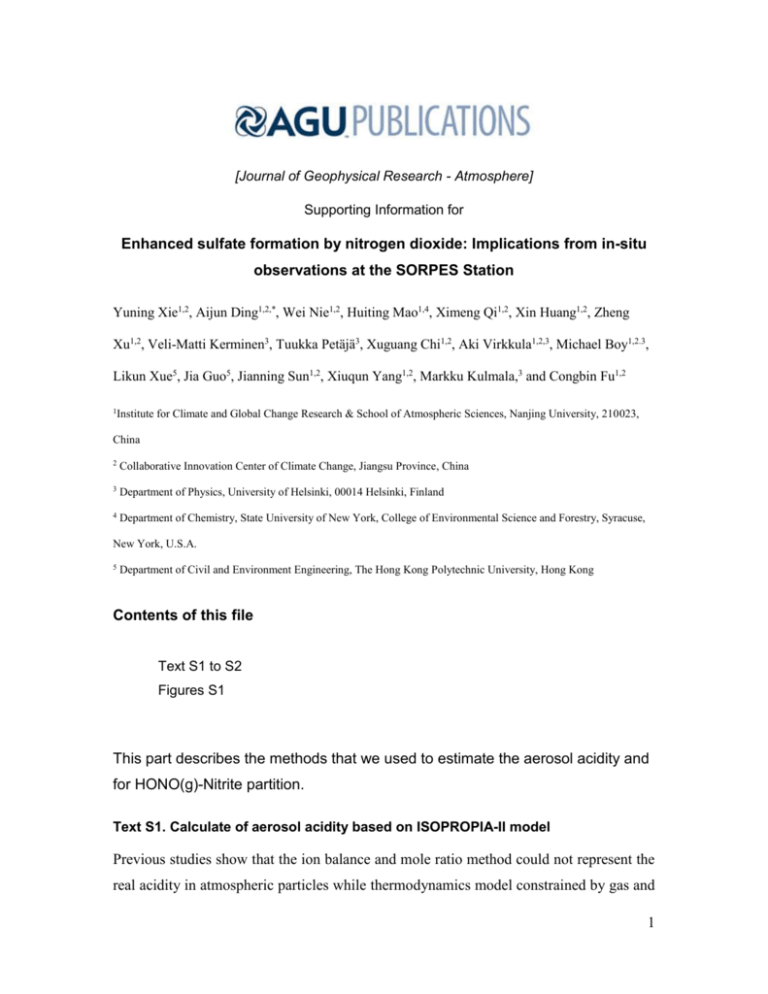
[Journal of Geophysical Research - Atmosphere] Supporting Information for Enhanced sulfate formation by nitrogen dioxide: Implications from in-situ observations at the SORPES Station Yuning Xie1,2, Aijun Ding1,2,*, Wei Nie1,2, Huiting Mao1,4, Ximeng Qi1,2, Xin Huang1,2, Zheng Xu1,2, Veli-Matti Kerminen3, Tuukka Petäjä3, Xuguang Chi1,2, Aki Virkkula1,2,3, Michael Boy1,2.3, Likun Xue5, Jia Guo5, Jianning Sun1,2, Xiuqun Yang1,2, Markku Kulmala,3 and Congbin Fu1,2 1Institute for Climate and Global Change Research & School of Atmospheric Sciences, Nanjing University, 210023, China 2 Collaborative Innovation Center of Climate Change, Jiangsu Province, China 3 Department of Physics, University of Helsinki, 00014 Helsinki, Finland 4 Department of Chemistry, State University of New York, College of Environmental Science and Forestry, Syracuse, New York, U.S.A. 5 Department of Civil and Environment Engineering, The Hong Kong Polytechnic University, Hong Kong Contents of this file Text S1 to S2 Figures S1 This part describes the methods that we used to estimate the aerosol acidity and for HONO(g)-Nitrite partition. Text S1. Calculate of aerosol acidity based on ISOPROPIA-II model Previous studies show that the ion balance and mole ratio method could not represent the real acidity in atmospheric particles while thermodynamics model constrained by gas and 1 aerosol measurement could provide reasonable results of the aerosol liquid water acidity [Yao et al., 2006; Hennigan et al,. 2015]. In this study, we used thermodynamics models ISORROPIA-II [Clegg et al., 1998; Clegg et al., 2003; Nenes et al., 1999; Fountoukis and Nenes, 2007] to estimate the acidity of the observed episode for the Case 2. The ISORROPIA II model uses concentration of gases and ions and relevant meteorological parameters to drive the forward model to establish an equilibrium aerosol mixture (solid plus liquid) and output the pH. The performance of the model was well described in Bian et al (2014). We obtained the model from ISORROPIA webpage (http://nenes.eas.gatech.edu/ISORROPIA). MARGA measured gas and ions concentrations, such as ammonia, ammonium, sulfate, sodium, calcium, potassium, magnesium, chloride, and nitrate, and air temperature, relative humidity were used as inputs for the model. The calculated pH value is 3.94, and liquid water content is 209 μg m-3. Text S2. Calculation of HONO-Nitrite partition The distribution factor of HONO, fHONO, is defined as the ratio of HONO aqueous phase to its gas-phase (i.e. NO2-/HONO), which could be estimated in the ideal solution according to the Henry`s law [Seinfeld and Pandis, 2006; VandenBoer et al., 2014]. It was shown as below: 𝑓𝐻𝑂𝑁𝑂 = 10−6 𝐻𝐻𝑂𝑁𝑂 𝑅𝑇𝐿 (1), where R is the ideal-gas constant equal to 0.08205 atm L mol-1K-1, T is the temperature in K, L is the water content of aerosol in g m-3, HHONO is the effective henry`s law constant which is defined as below: ∗ 𝐻𝐻𝑂𝑁𝑂 = 𝐻𝐻𝑂𝑁𝑂 (1 + 𝑘𝑎 𝐻+ ) (2), 𝑘𝑎 𝐻𝑂𝑁𝑂(𝑎𝑞) + 𝐻2 𝑂 ⇔ 𝐻 + + 𝑁𝑂2− (3) In the eq(2), we use Henry`s law constant (HHONO) in 298 K as 49 M atm-1 [Seinfeld and Pandis, 2006],the acid dissociation constant (ka) in 298 k as 5.1*10-4 M atm-1[Schwartz and White, 1981]. For liquid water content, we used the ISORROPIA II model calculated 2 value, i.e. 209 µg m-3. Then the fHONO dependence on the pH at 298 k was determined by substituting eq(1) and eq(2) and shown in Figure S1. The fHONO is about 0.04 at pH value of 6 and about 4.5x10-4 for pH value of 4. Figure S1 The dependence of fHONO to pH value calculated for the peak of Case 2 References Bian, Y. X., Zhao, C. S., Ma, N., Chen, J. and Xu. W. Y. (2014), A study of aerosol liquid water content based on hygroscopicity measurements at high relative humidity in the North China Plain, Atmos. Chem. Phys., 14, 6417–6426, doi: 10.5194/acp-14-6417-2014. Clegg, S. L., Brimblecombe, P., and Wexler, A. S. (1998): Thermodynamic model of the system H+, NH4+, SO42-, NO3-, H2O at tropospheric temperatures, J. Phys. Chem. A, 102, 2137–2154, doi:10.1021/Jp973042r. Clegg, S. L., Seinfeld, J. H., and Edney, E. O. (2003): Thermodynamic modelling of aqueous aerosols containing electrolytes and dissolved organic compounds. II. An extended Zdanovskii- StokesRobinson approach, J. Aerosol Sci., 34, 667–690, doi:10.1016/s0021-8502(03)00019-3. Fountoukis, C. and Nenes, A.( 2007): ISORROPIA II: a computationally efficient thermodynamic 3 – equilibrium model for K+, Ca2+, Mg2+, NH4+, Na+,SO42-, NO3 , Cl-, H2O aerosols, Atmos. Chem. Phys., 7, 4639–4659, doi:10.5194/acp-7-4639-2007. Hennigan, C. J., Izumi, J., Sullivan, A. P., Weber, R. J. and Nenes. A. (2015), A critical evaluation of proxy methods used to estimate the acidity of atmospheric particles, Atmos. Chem. Phys., 15, 2775–2790, doi: 10.5194/acp-15-2775-2015. Nenes, A., Pandis, S. N., and Pilinis, C. (1999): Continued development and testing of a new thermodynamic aerosol module for urban and regional air quality models, Atmos. Environ., 33, 1553–1560, doi:10.1016/S1352-2310(98)00352-5. Schwartz, S.E., White, W.H. (1981), Solubility equilibria of the nitrogen oxides and oxyacids in dilute aqueous solution, Adv. Environ. Sci. Eng., 4, 1-45. Seinfeld, J.H., Pandis, S.N. (2006), Atmospheric chemistry and physics: from air pollution to climate change. Wiley, New York. VandenBoer, T.C., Markovic, M.Z., Sanders, J.E., Ren, X., Pusede, S.E., Browne, E.C., Cohen, R.C., Zhang, L., Thomas, J., Brune, W.H., Murphy, J.G. (2014), Evidence for a nitrous acid (HONO) reservoir at the ground surface in Bakersfield, CA, during CalNex 2010. J. Geophys. Res., 119, 9093-9106. Yao, X. H., Ling, T. Y., Fang, M., and Chan, C. K. (2006): Comparison of thermodynamic predictions for in situ pH in PM2.5, Atmos. Environ., 40, 2835–2844, doi:10.1016/j.atmosenv.2006.01.006. 4



